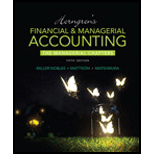
Kathy Wintz formed a lawn service business as a summer job. To start the corporation on May 1, 2016, she deposited $1,000 in a new bank account in the name of the business. The $1,000 consisted of a $600 loan from Bank One to her company, Wintz Lawn Service, and $400 of her own money. The company issued $400 of common stock to Wintz. Wintz rented lawn equipment, purchased supplies, and hired other students to mow and trim customers’ lawns.
At the end of each month, Wintz mailed bills to the customers. On August 31, she was ready to dissolve the corporation and return to college. Because she was so busy, she kept few records other than the checkbook and a list of receivables from customers.
At August 31, the business’s checkbook shows a balance of $2,000, and customers still owe $750. During the summer, the business collected $5,500 from customers. The business checkbook lists payments for supplies totaling $400, and it still has gasoline, weed trimmer cord, and other supplies that cost a total of$50. The business paid employees $1,800 and still owes them $300 for the final week of the summer.
Wintz rented some equipment from Ludwig’s Machine Shop. On May 1, the business signed a six-month rental agreement on mowers and paid $600 for the full rental period in advance. Ludwig’s will refund the unused portion of the prepayment
if the equipment is returned in good shape. In order to get the refund, Wintz has kept the mowers in excellent condition. In fact, the business had to pay $300 to repair a mower.
To transport employees and equipment to jobs, Wintz used a trailer that the business bought for $300. The business estimates that the summer's work used up one-third of the trailer’s service potential. The business checkbook lists a payment of $500 for cash dividends paid during the summer. The business paid the loan back during August. (For simplicity, ignore any interest expense associated with the loan.)
Requirements
1. As a team, prepare the income statement and the statement of
2. Prepare the classified
3. Was Wintz’s summer work successful? Give your team’s reason for your answer.
Want to see the full answer?
Check out a sample textbook solution
Chapter 4 Solutions
Horngren's Financial & Managerial Accounting, The Managerial Chapters (5th Edition)
- Brightwood Furniture provides the following financial data for a given period: Sales Amount ($) Per Unit ($) 150,000 Less Variable Expenses 90,000 25 15 10 35,000 25,000 Contribution Margin 60,000 Less Fixed Expenses Net Income a. What is the company's CM ratio? b. If quarterly sales increase by $5,200 and there is no change in fixed expenses, by how much would you expect quarterly net operating income to increase?arrow_forwardSubject: financial accountingarrow_forwardProvide Answerarrow_forward
 Individual Income TaxesAccountingISBN:9780357109731Author:HoffmanPublisher:CENGAGE LEARNING - CONSIGNMENT
Individual Income TaxesAccountingISBN:9780357109731Author:HoffmanPublisher:CENGAGE LEARNING - CONSIGNMENT



